Illegal Abandoned Waste Sites (IAWSs): A Multi-Parametric GIS-Based Workflow for Waste Management Planning and Cost Analysis Assessment
Abstract
1. Introduction
- -
- Use of open-source software (e.g., QGIS 3.42.1 ‘Münster’, Bizagi Modeler 4.1);
- -
- Integration of satellite data to optimize ground surveys;
- -
- Product and volume analysis;
- -
- Application of algorithms to define optimal routes for waste collection and transportation.
GIS for Waste Management Planning
2. Materials and Methods
2.1. Overview and Ancillary Data
2.2. Satellite Pre-Recognition Phase
Kernel Density Function (KDF) Maps and Python Script Design
2.3. Ground Investigation (2.5D Volumes and Product Analysis)
2.4. Application of Dijkstra’s Algorithm in a GIS Environment for Waste Transport Planning
2.5. Cost Analysis (Functional Unit, Transport, and Plant Management)
- (1)
- Transport and waste management category. The transportation costs, firstly, concern the paths from IAWSs to transfer stations and, secondly, the paths from transfer stations to disposal plants. The cost of transport in Italy is influenced by various factors, including vehicle acquisition, fuel prices, maintenance, and personnel expenses. Accordingly, the Italian Ministry of Infrastructure and Transport periodically publishes indicative cost values for the road transport sector. Following the provisions of Article 1, paragraph 250, of Law No. 190 of 23 December 2014, these reference values replaced the previously mandated “minimum transport costs” established under Article 83-bis of Decree-Law No. 112 of 25 June 2008. The latest update, based on inflation trends recorded by ISTAT and fuel price variations reported by the Ministry of Ecological Transition, provides revised unit costs per kilometer as of January 2022 [33].
- (2)
- Waste treatment plant category. The waste treatment plant categories are considered both for the landfill and incineration scenarios. Direct sources for costs are associated in relation to the category of management plant.
3. Results
3.1. Satellite Pre-Recognition Analysis
3.2. Ground Investigation
- Sersale, Cropani, and Soveria Simeri districts within the study area (grey line);
- Potential IAWSs recognized by satellite-based analysis (red crosses, transparency 30%);
- IAWSs detected as a result of the ground-based analysis (171 green crosses with a black dot).
3.3. Application of Dijkstra’s Algorithm in a GIS Environment for Waste Transport Planning
- Cutro transfer station area: 41 IAWSs;
- Sellia Marina transfer station area: 102 IAWSs;
- Cerva transfer station area: 28 IAWSs.
- Sellia Marina transfer station (green and red dot);
- Sellia Marina IAWSs identified as a result of the ground-based analysis (green and white dots);
- Shortest path Sellia Marina (black dashed lines);
- Sellia Marina transfer station buffer zone (red circumference).
- Cerva transfer station (pink and red dot);
- Cerva IAWSs identified as a result of the ground-based analysis (pink and white dots);
- Shortest path (black dashed lines);
- Buffer zone (red circumference).
- Cutro transfer station (violet and red dot);
- Cutro IAWSs identified as a result of the ground-based analysis (violet and white dots);
- Shortest path (black dashed lines);
- Buffer zone (red circumference).
3.4. Cost Analysis Models
- -
- T1: the transportation cost from dumpsites to transfer stations is the same for both scenarios (€6307.4 or €12.8/ton).
- -
- T2.1: the cost of transporting waste to the Crotone landfill in Scenario 1 (€3629.8 or €7.3/ton) is lower than the equivalent cost in S2 for inert waste (€7.1/ton), as S2 reduces the amount of waste transported due to separation.
- -
- T2.2: Scenario 2 incurs additional transportation costs (€5725.4 or €18.7/ton) due to the transport of mixed waste to the Gioia Tauro plant.
- -
- M1: landfill disposal costs are significantly higher in S1 (€49,465.0 or €100.0/ton) than in S2 (€18,875.6 or €100.0/ton), as S2 only disposes of the inert fraction in the landfill.
- -
- M2: incineration costs in S2 (€33,648.4 or €110.0/ton) can replace full landfill disposal, offering energy recovery as a benefit.
4. Discussion
- (1)
- Use of open-source software and an Excel-based scenario;
- (2)
- Satellite remote sensing as a pre-analysis stage to set ground surveys;
- (3)
- In-situ ground survey activities for geo-localization refinement and qualitative/quantitative product and 2.5D volume analyses of waste piles;
- (4)
- Use of ancillary data (primary and secondary road networks, transfer stations, disposal plants) and application of the Dijkstra algorithm (QGIS, Shortest Path tool—point to layer);
- (5)
- Cost analysis and waste management planning.
5. Conclusions
Author Contributions
Funding
Data Availability Statement
Conflicts of Interest
References
- Wenheng, W.; Shuwen, N. Impact study on human activity to the resource-environment based on the consumption level difference of China’s Provinces or autonomous regions. China Popul. Resour. Environ. 2008, 18, 121–127. [Google Scholar] [CrossRef]
- Salami, L.; Popoola, L.T. A comprehensive review of atmospheric air pollutants assessment around landfill sites. Air Soil Water Res. 2023, 16, 11786221221145379. [Google Scholar] [CrossRef]
- Giusti, L. A Review of Waste Management Practices and Their Impact on Human Health. Waste Manag. 2009, 29, 2227–2239. [Google Scholar] [CrossRef] [PubMed]
- Karimi, N.; Ng, K.T.W.; Richter, A. Development and application of an analytical framework for mapping probable illegal dumping sites using nighttime light imagery and various remote sensing indices. Waste Manag. 2022, 143, 195–205. [Google Scholar] [CrossRef]
- Jakiel, M.; Bernatek-Jakiel, A.; Gajda, A.; Filiks, M.; Pufelska, M. Spatial and temporal distribution of illegal dumping sites in the nature protected area: The Ojców National Park, Poland. J. Environ. Plan. Manag. 2019, 62, 286–305. [Google Scholar] [CrossRef]
- Jiang, P.; Fan, Y.V.; Zhou, J.; Zheng, M.; Liu, X.; Klemeš, J.J. Data-driven analytical framework for waste-dumping behaviour analysis to facilitate policy regulations. Waste Manag. 2020, 103, 285–295. [Google Scholar] [CrossRef]
- Ghosh, A.; Richter, A.; Ng, K.T.W. Applications of Geographic Information Systems to site waste facilities in Saskatchewan—Phase. In Proceedings of the Canadian Society of Civil Engineering Annual Conference 2021, Lecture Notes in Civil Engineering, Ottawa, ON, Canada, 14–17 June 2011; Volume 249, pp. 173–182. [Google Scholar]
- Quesada-Ruiz, L.C.; Rodriguez-Galiano, V.; Jordá-Borrell, R. Characterization and mapping of illegal landfill potential occurrence in the Canary Islands. Waste Manag. 2019, 85, 506–518. [Google Scholar] [CrossRef]
- Yadav, R.; Sahu, L.K.; Jaaffrey, S.N.A.; Beig, G. Temporal Variation of Particulate Matter (PM) and Potential Sources at an Urban Site of Udaipur in Western India. Aerosol Air Qual. 2014, 14, 1613–1629. [Google Scholar] [CrossRef]
- Mahmood, K.; Batool, S.A.; Chaudhry, M.N. Studying bio-thermal effects at and around MSW dumps using Satellite Remote Sensing and GIS. Waste Manag. 2016, 55, 118–128. [Google Scholar] [CrossRef]
- Karimi, N.; Richter, A.; Ng, K.T.W. Siting and ranking municipal landfill sites in regional scale using nighttime satellite imagery. J. Environ. Manag. 2020, 256, 109942. [Google Scholar] [CrossRef]
- Papale, L.G.; Guerrisi, G.; De Santis, D.; Schiavon, G.; Del Frate, F. Satellite Data Potentialities in Solid Waste Landfill Monitoring: Review and Case Studies. Sensors 2023, 23, 3917. [Google Scholar] [CrossRef] [PubMed]
- Ottavianelli, G.; Hobbs, S.; Smith, R.; Bruno, D. Assessment of Hyperspectral and SAR Remote Sensing for Solid Waste Landfill Management; European Space Agency: Frascati, Italy, 2005; (Special Publication) ESA SP. [Google Scholar]
- Gemitzi, A.; Tsihrintzis, V.A.; Voudrias, E.; Petalas, C.; Stravodimos, G. Combining geographic information system, multicriteria evaluation techniques and fuzzy logic in siting MSW landfills. Environ. Geol. 2007, 51, 797–811. [Google Scholar] [CrossRef]
- Richter, A.; Ng, K.T.W.; Karimi, N.; Chang, W. Developing a novel proximity analysis approach for assessment of waste management cost efficiency in low population density regions. Sustain. Cities Soc. 2021, 65, 102583. [Google Scholar] [CrossRef]
- Singh, G.; Singh, B.; Rathi, S.; Haris, S. Solid Waste Management using Shortest Path Algorithm. Int. J. Eng. Sci. Invent. Res. Dev. 2014, 1, 60–64. [Google Scholar]
- Maspaitella, B.J.; Susanty, A.; Purwaningsih, R. Waste transportation route garbage using network analysis method, a research method design. IOP Conf. Ser. Mater. Sci. Eng. 2021, 1072, 012025. [Google Scholar] [CrossRef]
- Mati Asefa, E.; Bayu Barasa, K.; Adare Mengistu, D. Application of Geographic Information System in Solid Waste Management; IntechOpen: London, UK, 2022. [Google Scholar]
- Dijkstra, E.W. A note on two problems in connection with graphs. Numer. Math. 1959, 1, 269–271. [Google Scholar] [CrossRef]
- Hannan, M.A.; Begum, R.A.; Al-Shetwi, A.Q.; Ker, P.J.; Al Mamun, M.A.; Hussain, A.; Basri, H.; Mahlia, T.M.I. Waste collection route optimisation model for linking cost saving and emission reduction to achieve sustainable development goals. Sustain. Cities Soc. 2020, 62, 102393. [Google Scholar] [CrossRef]
- Kontos, T.D.; Komilis, D.P.; Halvadakis, C.R. Siting MSW landfills on Lesvos Island with a GIS-based methodology. Waste Manag. Res. 2003, 21, 262–277. [Google Scholar] [CrossRef]
- Cleary, J. The incorporation of waste prevention activities into life cycle assessments of municipal solid waste management systems: Methodological issues. Int. J. Life Cycle Assess. 2010, 15, 579–589. [Google Scholar] [CrossRef]
- ISPRA. Municipal Waste Report—2022 (Edition 355/2021); ISPRA: Rome, Italy, 2022.
- Liang, J.; Gong, J.; Li, W. Applications and impacts of Google Earth: A decadal review (2006–2016). ISPRS J. Photogramm. Remote Sens. 2018, 146, 91–107. [Google Scholar] [CrossRef]
- Biljecki, F.; Ito, K. Street view imagery in urban analytics and GIS: A review. Landsc. Urban Plan. 2021, 215, 104217. [Google Scholar] [CrossRef]
- Carper, W.; Lillesand, T.M.; Kiefer, R.W. The use of Intensity-Hue-Saturation transformations for merging SPOT panchromatic and multispectral image data. Photogramm. Eng. Remote Sens. 1990, 56, 1067–1074. [Google Scholar]
- WEEE Coordination Center. Available online: https://www.cdcraee.it/ (accessed on 29 March 2024).
- Agbogbloshie Makerspace Platform (AMP). Available online: https://qamp.net/library/microwave-ovens/ (accessed on 29 March 2024).
- Zero Waste Europe. Available online: http://zerowastecities.eu (accessed on 29 March 2024).
- International Atomic Energy Agency (IAEA). Available online: http://www-pub.iaea.org (accessed on 29 March 2024).
- Manea, A.; Dolci, G.; Grosso, M. Life cycle assessment and cost analysis of an innovative automatic system for sorting municipal solid waste: A case study at Milan Malpensa airport. Waste Manag. 2024, 183, 63–73. [Google Scholar] [CrossRef] [PubMed]
- Ministry of Infrastructure and Transport Data. 2022. Available online: https://www.mit.gov.it/ (accessed on 29 March 2024).
- Ministry of Ecological Transition. 2022. Available online: https://sisen.mase.gov.it/dgsaie/ (accessed on 29 March 2024).
- Steubing, B.; Wernet, G.; Reinhard, J.; Bauer, C.; Moreno-Ruiz, E. The ecoinvent database version 3 (part II): Analyzing LCA results and comparison to version 2. Int. J. Life Cycle Assess. 2016, 21, 1269–1281. [Google Scholar] [CrossRef]
- Mei, A.; Baiocchi, V.; Mattei, S.; Zampetti, E.; Pai, H.-J.; Tratzi, P.; Ragazzo, A.V.; Cuzzucoli, A.; Mancuso, A.; Bearzotti, A.; et al. Conceptualization of a satellite, UAS and UGV downscaling approach for abandoned waste detection and waste to energyprospects. Int. Arch. Photogramm. Remote Sens. Spat. Inf. Sci. 2023, 26, 287–293. [Google Scholar] [CrossRef]
- Ghose, M.K.; Dikshit, A.K.; Sharma, S.K. A GIS-based transportation model for solid waste disposal—A case study on Asansol municipality. Waste Manag. 2006, 26, 1287–1293. [Google Scholar] [CrossRef]
- Malakahmad, A.; Bakri, P.M.; Mokhtar, M.R.; Khalil, N. Solid Waste Collection Routes Optimization via GIS Techniques in Ipoh City, Malaysia. Procedia Eng. 2014, 77, 20–27. [Google Scholar] [CrossRef]
- Hatamleh, R.I.; Jamhawi, M.M.; Al-Kofahi, S.D.; Hijazi, H. The Use of a GIS System as a Decision Support Tool for Municipal Solid Waste Management Planning: The Case Study of Al Nuzha District, Irbid, Jordan. Procedia Manuf. 2020, 44, 189–196. [Google Scholar] [CrossRef]
- Baral, A.; Rafizul, I.M.; Das, S.; Bernar, S. Economic and environmental benefits of optimized waste transportation routes in Khulna. Environ. Chall. 2024, 17, 101023. [Google Scholar] [CrossRef]
- Deswal, M.; Laura, J.S. Application of GIS in MSW management in India. Int. J. Eng. Res. Dev. 2014, 10, 24–32. [Google Scholar]
- Khajuria, A.; Matsui, T.; Machimura, T. GIS Application for Estimating the Current Status of Municipal Solid Waste Management System: Case Study of Chandigarh City, India. Our Nat. 2012, 9, 26–33. [Google Scholar] [CrossRef]
- Siddam, S.; Khadikar, I.; Chitade, A.Z. Route Optimisation for Solid Waste Management Using Geo-Informatics. IOSR J. Mech. Civ. Eng. 2012, 2, 78–83. [Google Scholar] [CrossRef]
- Goel, S. Advances in Solid and Hazardous Waste Management; Springer: Cham, Switzerland, 2017. [Google Scholar]
- Li, X.; Zhang, C.; Li, W.; Ricard, R.; Meng, Q.; Zhang, W. Assessing street-level urban greenery using Google Street View and a modified green view index. Urban For. Urban Green. 2015, 14, 675–685. [Google Scholar] [CrossRef]
- Kang, Y.; Zhang, F.; Gao, S.; Lin, H.; Liu, Y. A review of urban physical environment sensing using street view imagery in public health studies. Ann. GIS 2020, 26, 261–275. [Google Scholar] [CrossRef]
- Cicala, L.; Gargiulo, F.; Parrilli, S.; Amitrano, D.; Pigliasco, G. Progressive Monitoring of Micro-Dumps Using Remote Sensing: An Applicative Framework for Illegal Waste Management. Sustainability 2024, 16, 5695. [Google Scholar] [CrossRef]
- Syafrudin, S.; Ramadan, B.S.; Budihardjo, M.A.; Munawir, M.; Khair, H.; Rosmalina, R.T.; Ardiansyah, S.Y. Analysis of Factors Influencing Illegal Waste Dumping Generation Using GIS Spatial Regression Methods. Sustainability 2023, 15, 1926. [Google Scholar] [CrossRef]
- Ichipi, E.B.; Senekane, M.F. An Evaluation of the Impact of Illegal Dumping of Solid Waste on Public Health in Nigeria: A Case Study of Lagos State. Int. J. Environ. Res. Public Health 2023, 20, 7069. [Google Scholar] [CrossRef]
- Ngalo, N.; Thondhlana, G. Illegal Solid-Waste Dumping in a Low-Income Neighbourhood in South Africa: Prevalence and Perceptions. Int. J. Environ. Res. Public Health 2023, 20, 6750. [Google Scholar] [CrossRef]
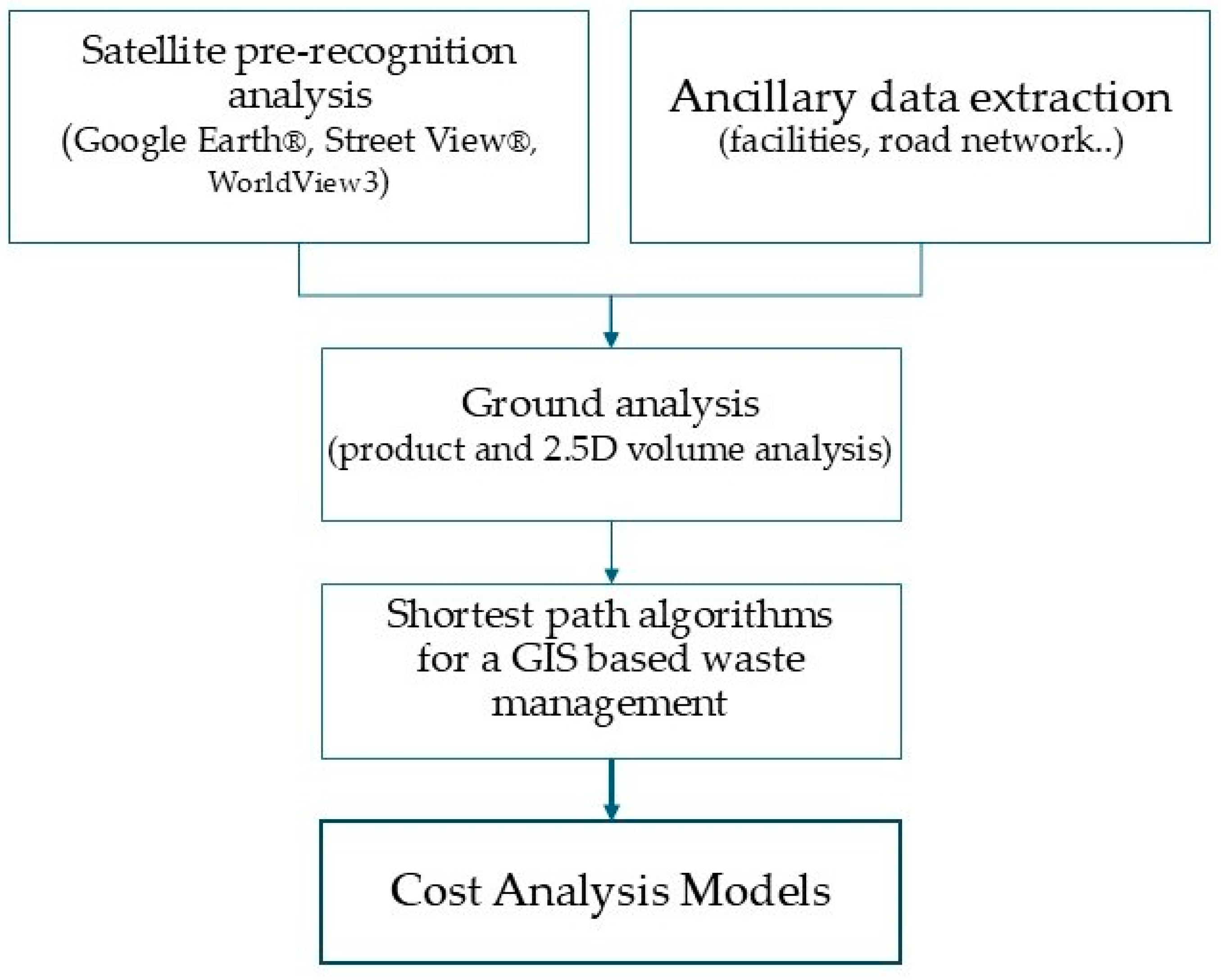
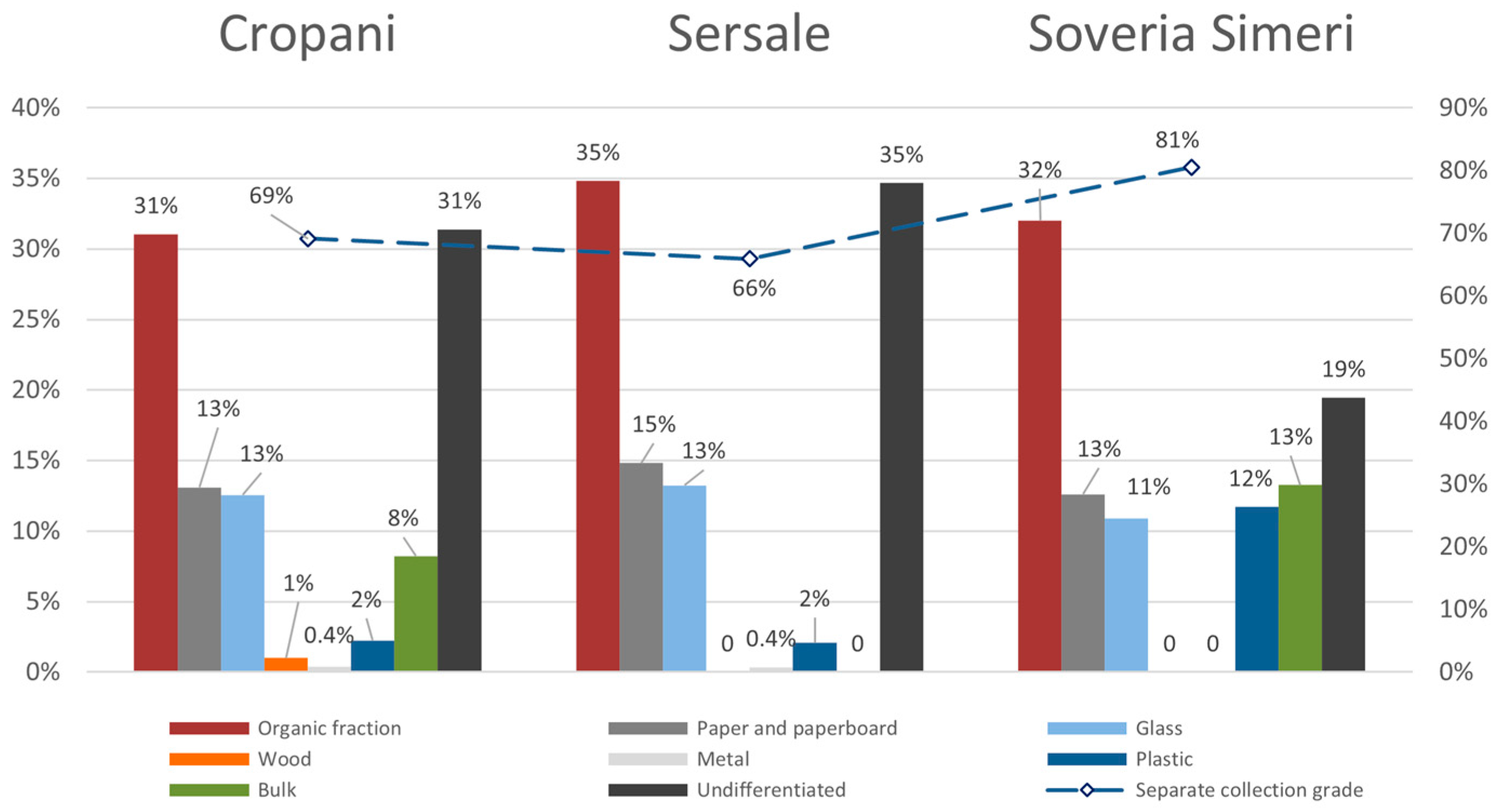
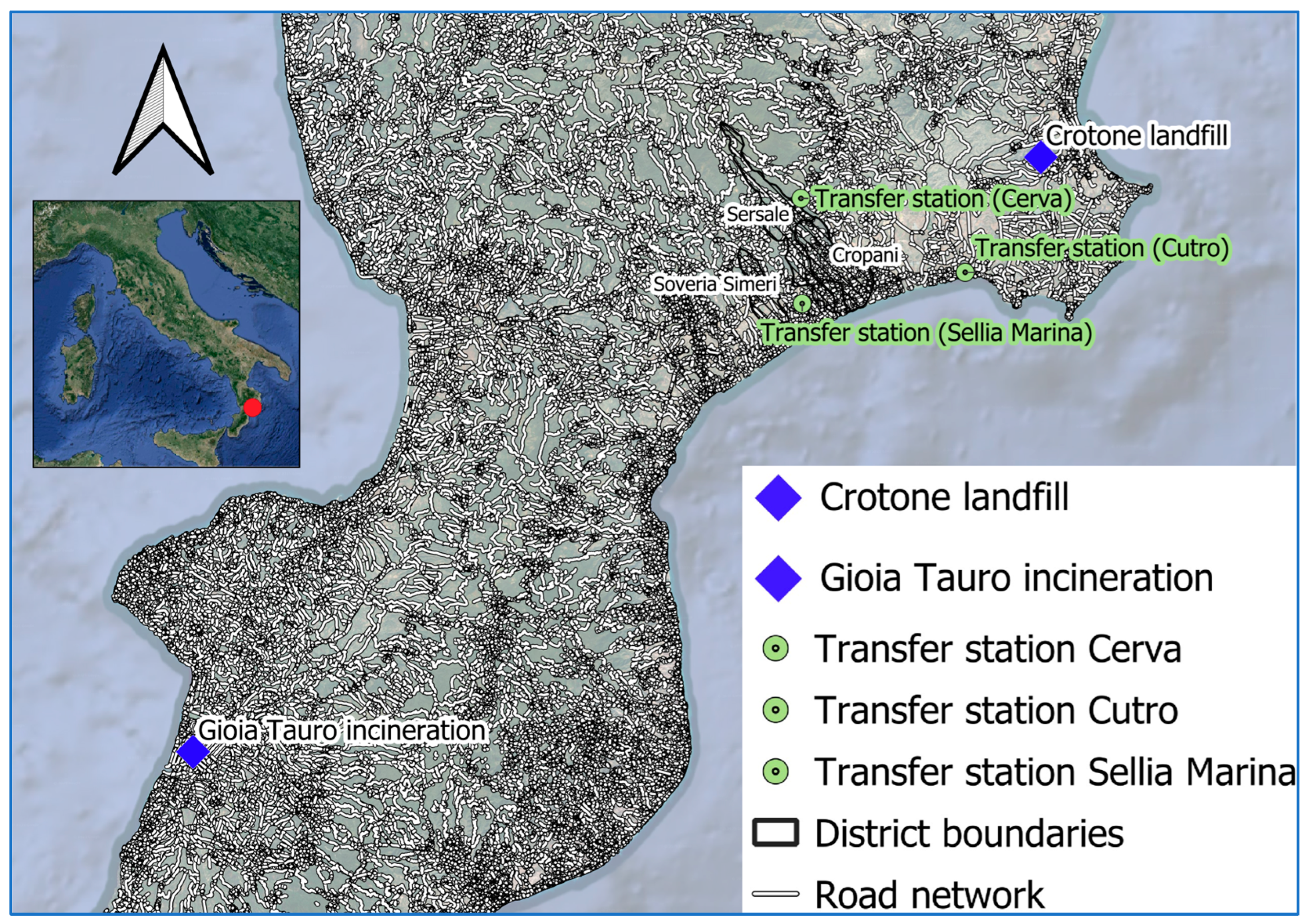



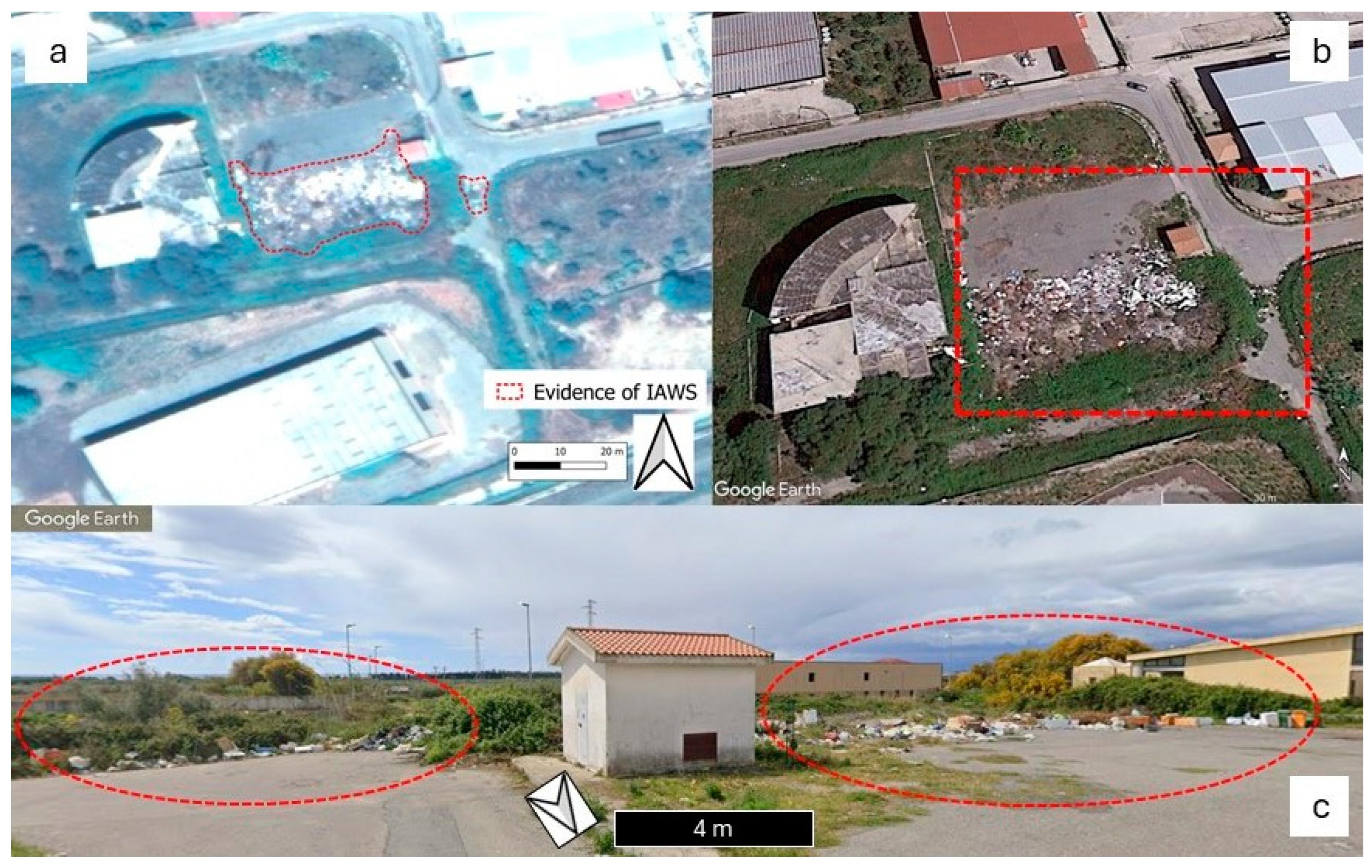
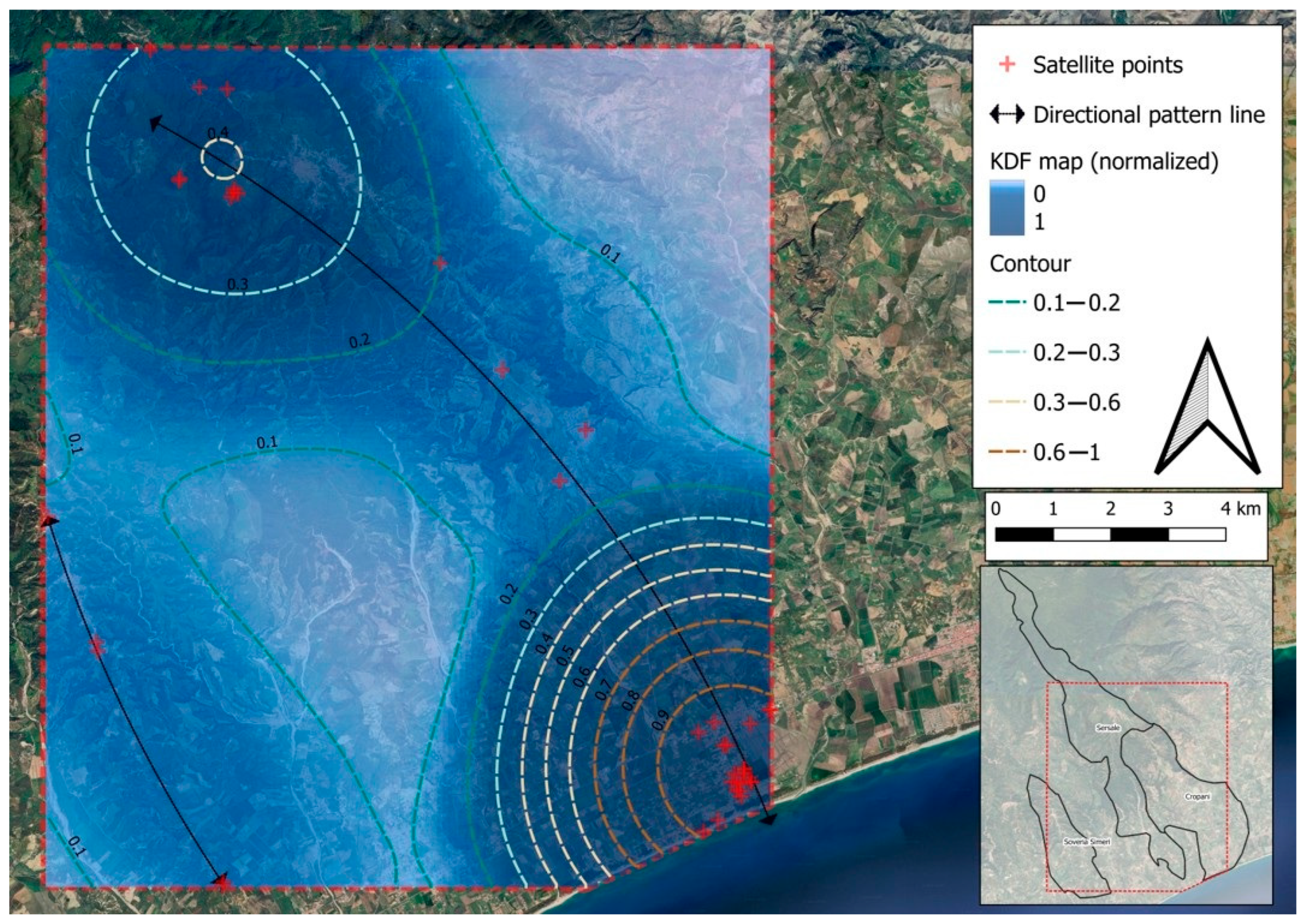
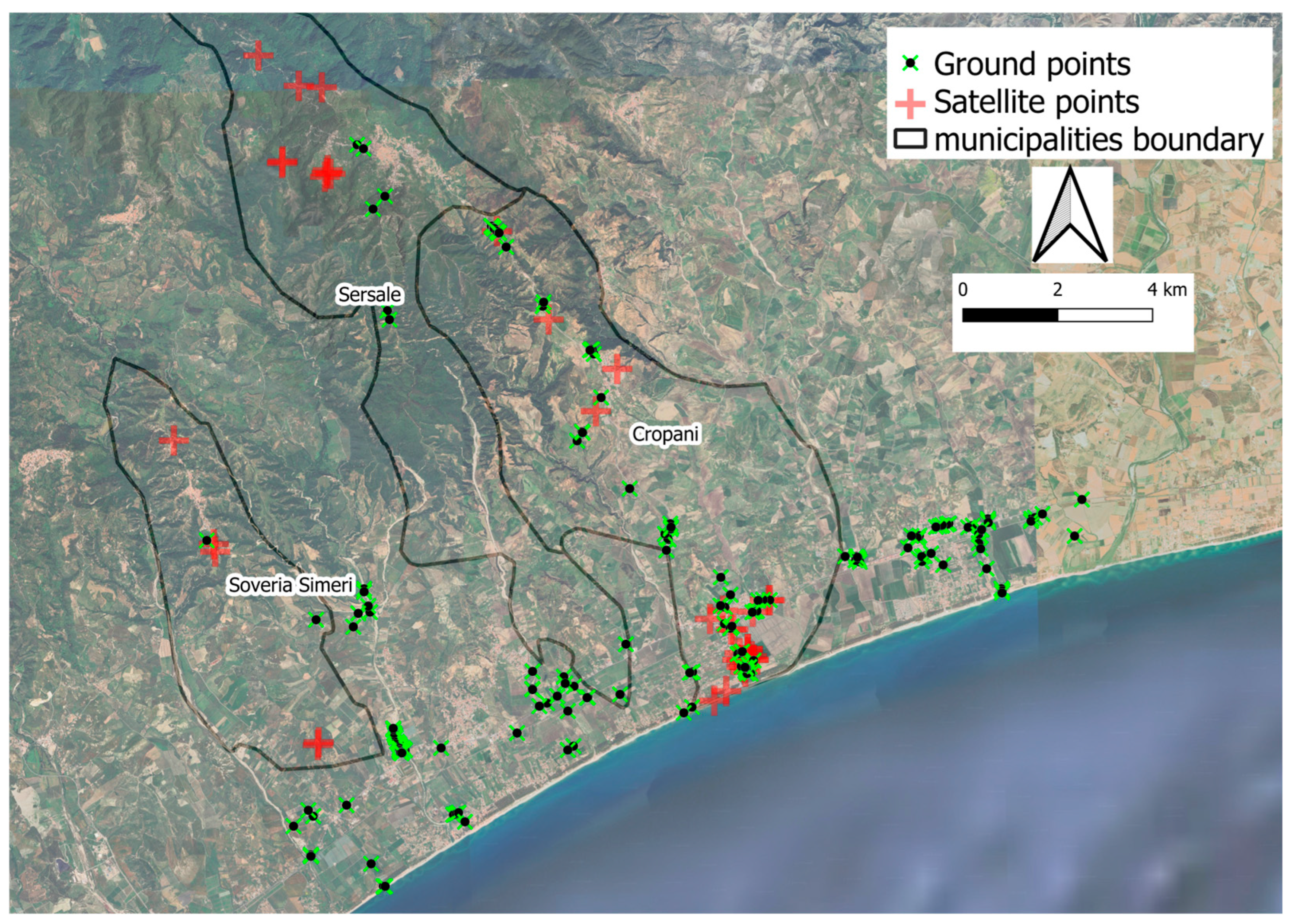


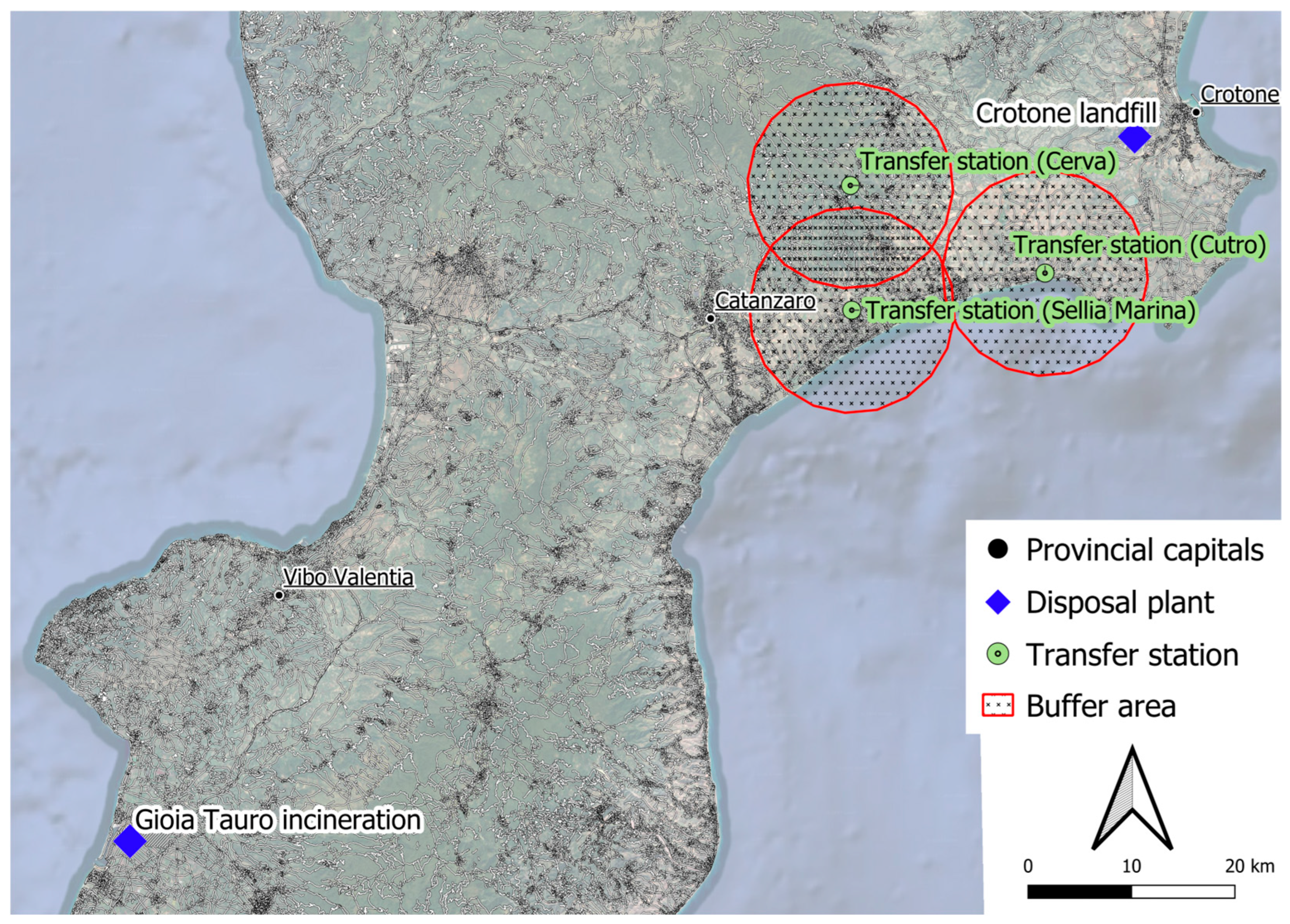
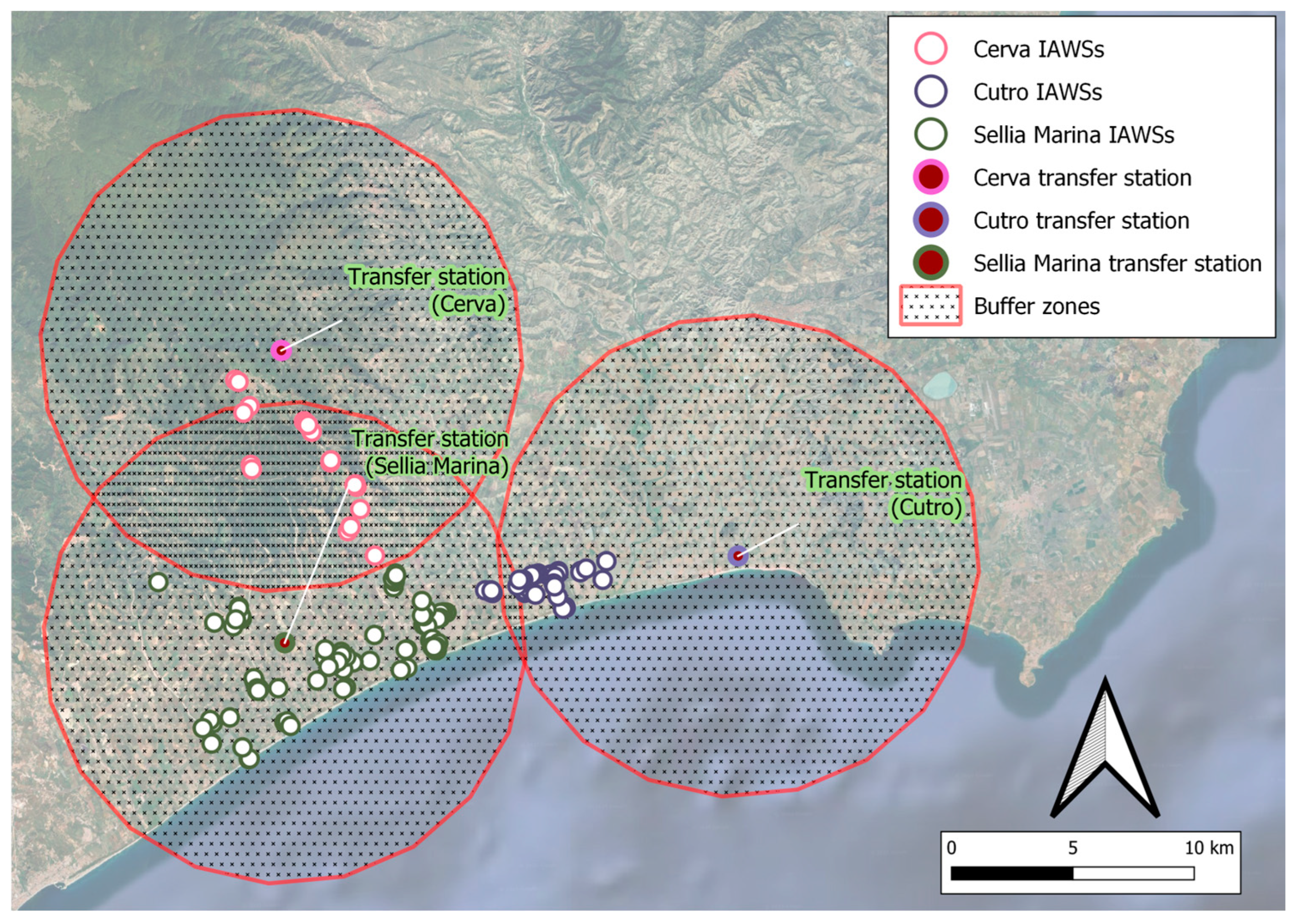
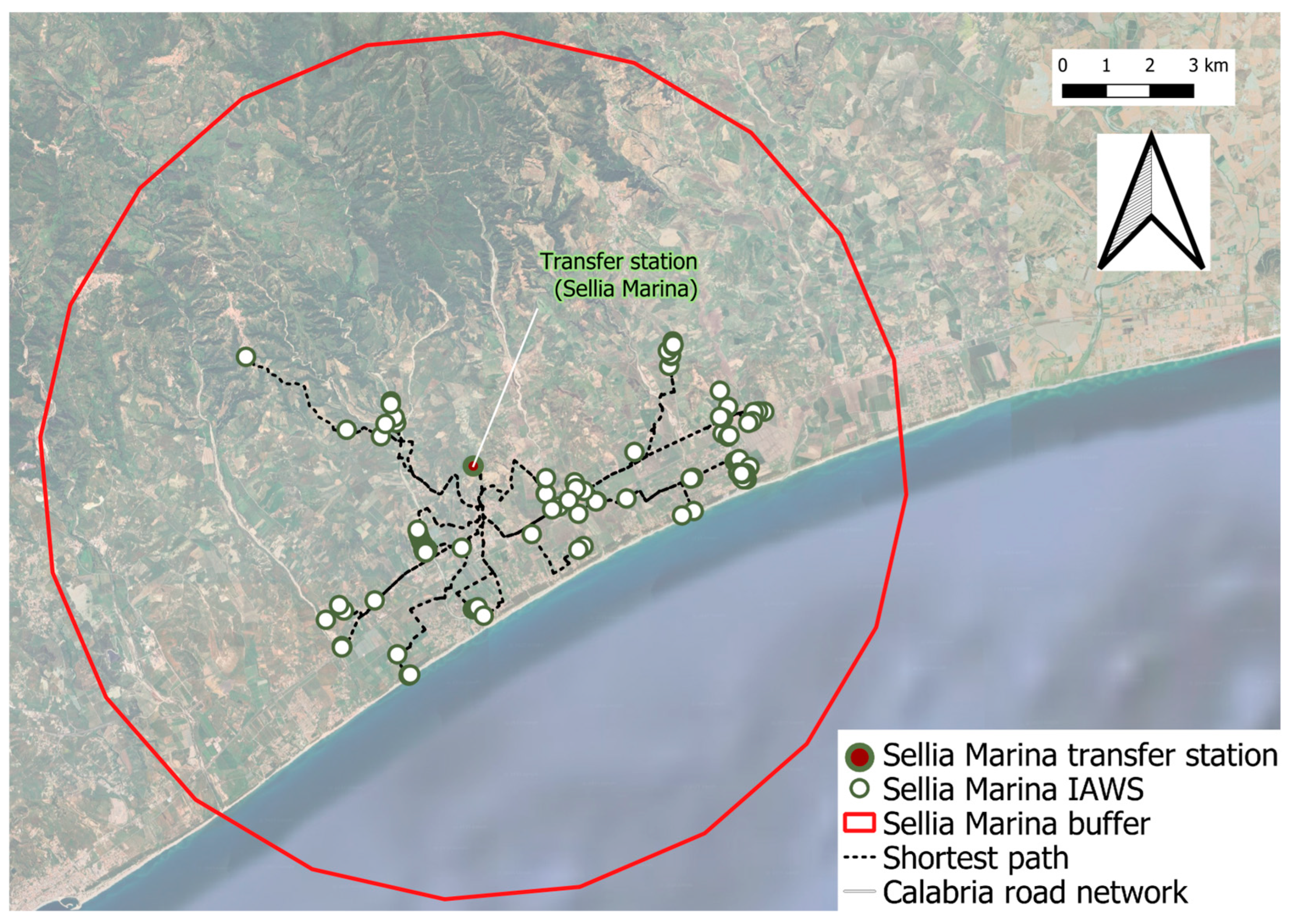


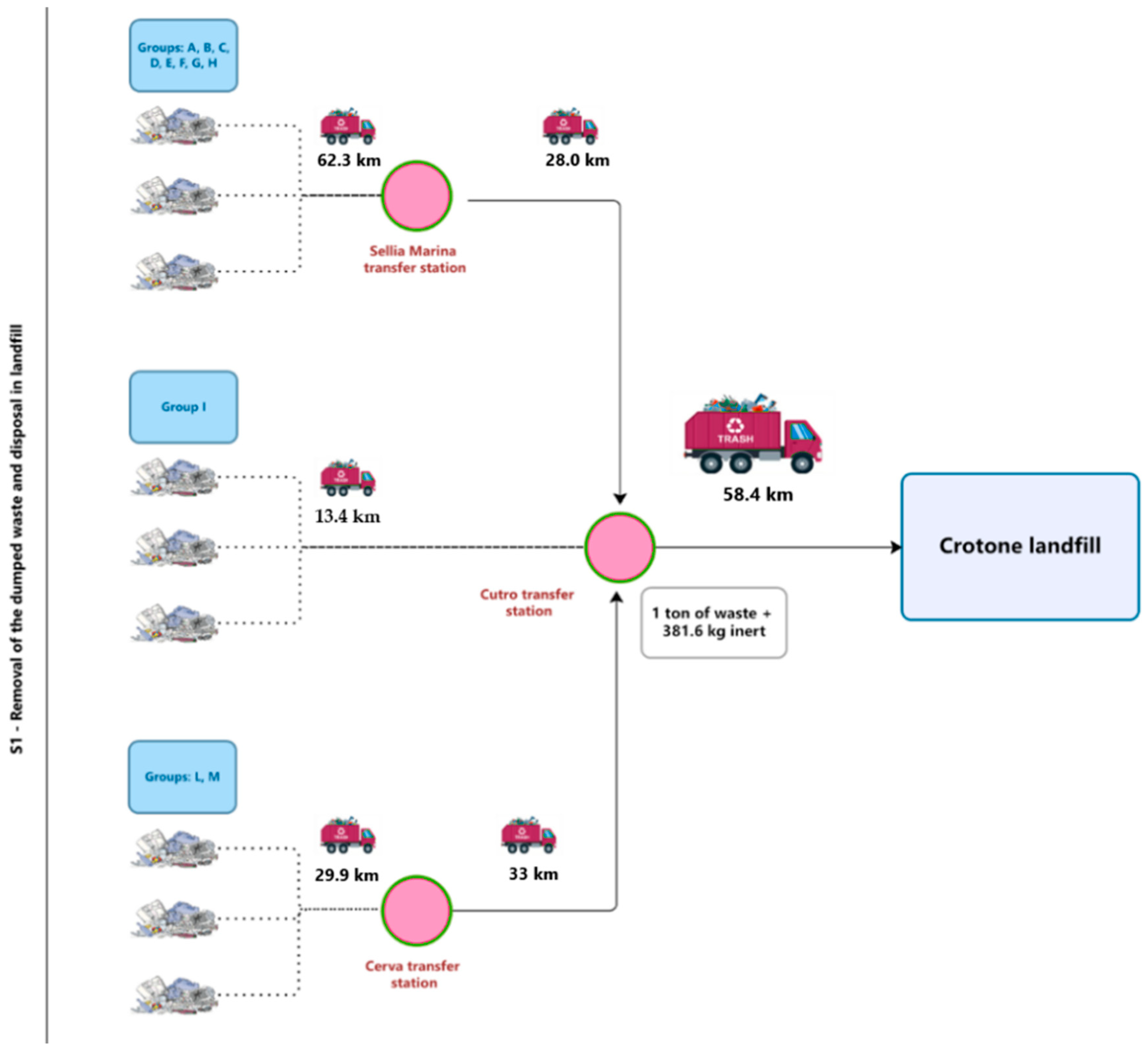
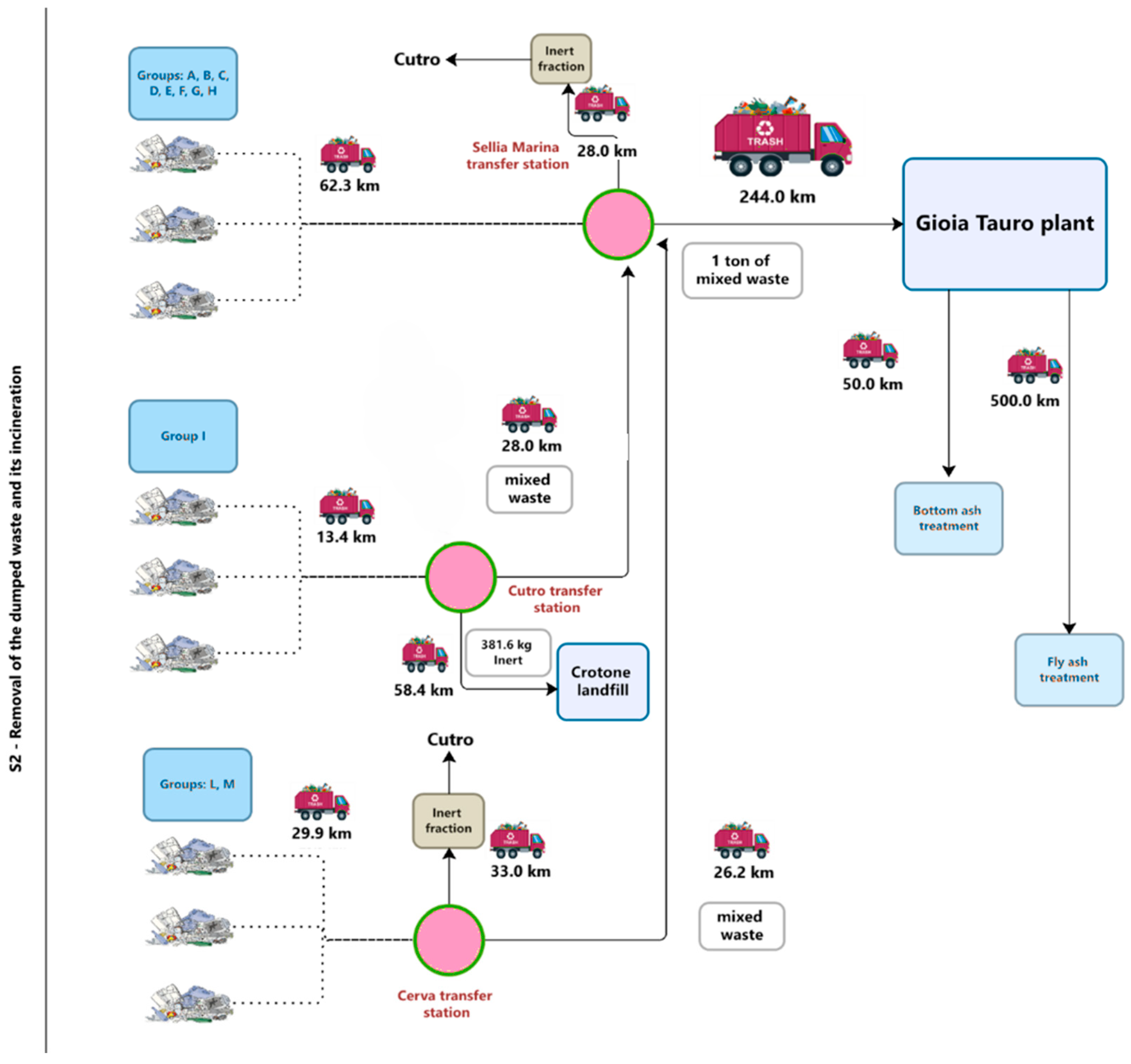
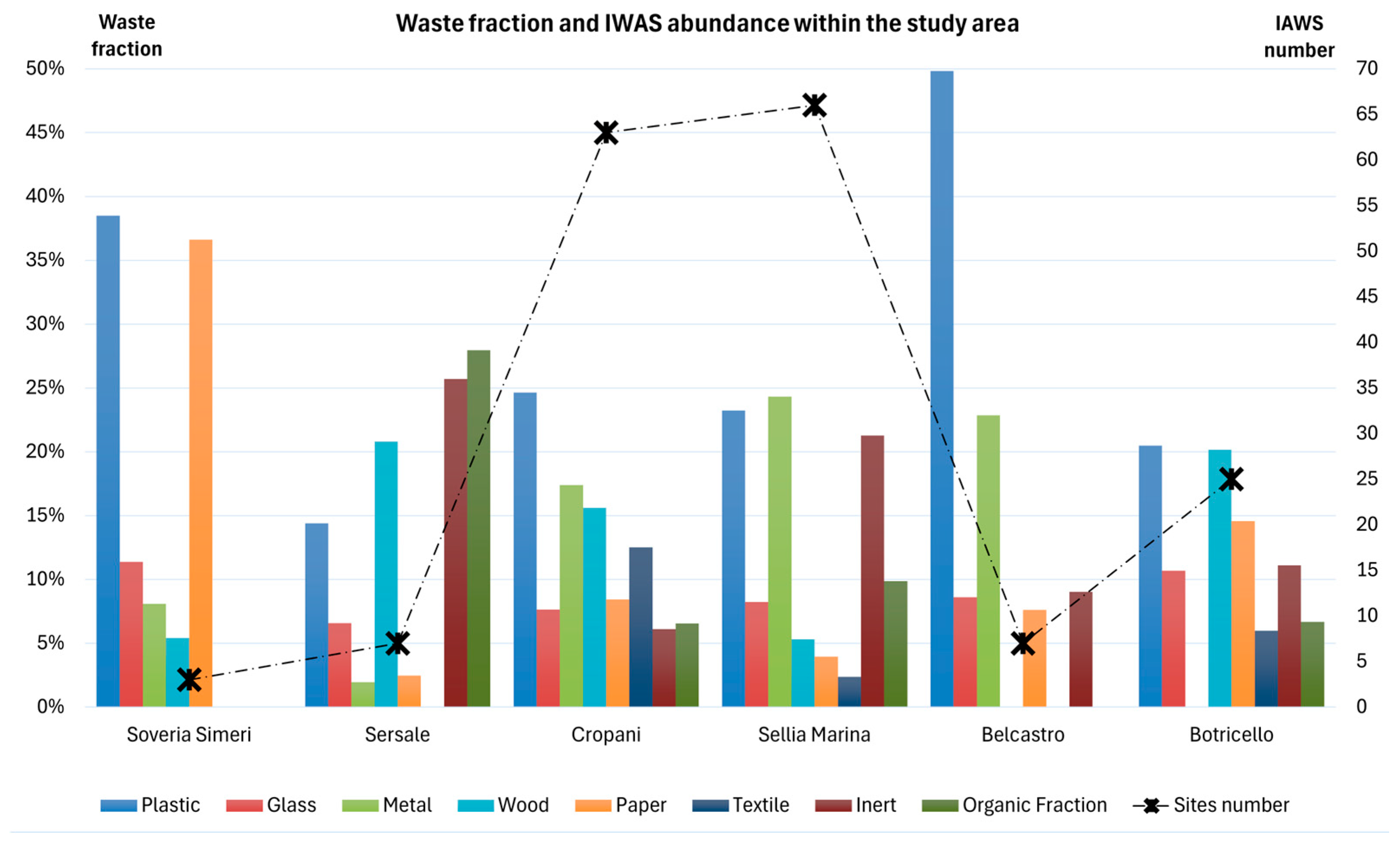
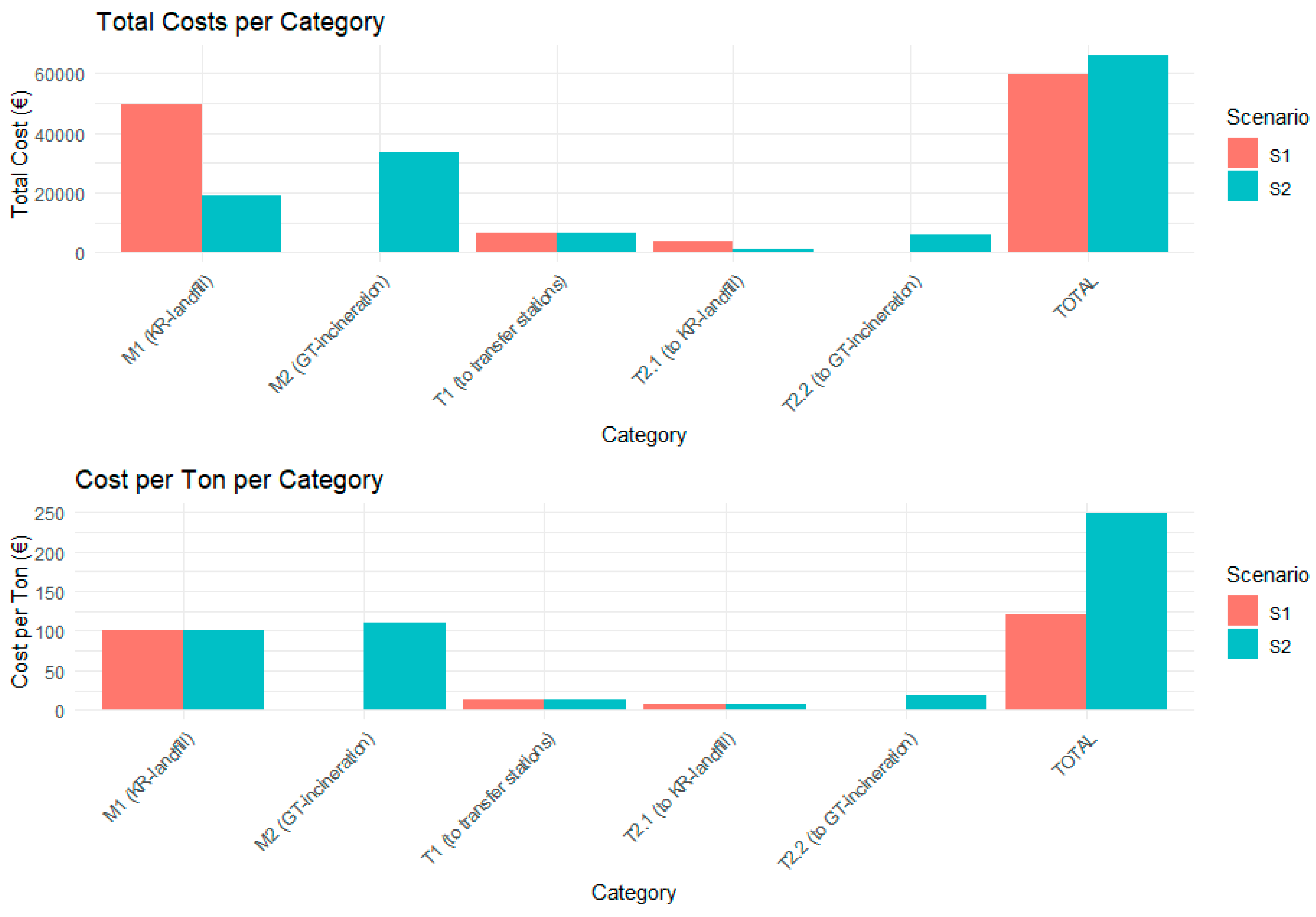
| Facilities | Units 2015 | Units 2021 |
|---|---|---|
| Composting | 7 | 11 |
| Aerobic and anaerobic integrated system | 0 | 1 |
| Anaerobic digestion | 0 | 0 |
| Mechanical biological treatment | 8 | 8 |
| Incineration | 1 | 1 |
| Co-incineration | 1 | 1 |
| Landfill | 6 | 5 |
| Class | Item | Material | Percentage | Density (kg/m3) | Mean Mass (kg) | Reference |
|---|---|---|---|---|---|---|
| Bulk | Washing machine | Steel | 37% | 40 | https://www.cdcraee.it/, accessed on 29 January 2025 [27] | |
| Al and Cu | 2% | |||||
| Plastic | 13% | |||||
| Fridge | Steel | 47% | 50 | https://www.cdcraee.it/, accessed on 29 January 2025 [27] | ||
| Aluminum | 5% | |||||
| Plastic | 11% | |||||
| Oven | Steel | 49% | 15 | https://qamp.net/library/microwave-ovens/, accessed on 29 January 2025 [28] | ||
| Al and Cu | 12% | |||||
| Plastic | 1% | |||||
| TV (CRT) | Steel | 14% | 12 | https://www.cdcraee.it/, accessed on 29 January 2025 [29,30] | ||
| Al and Cu | 5% | |||||
| Plastic | 20% | |||||
| Glass | 48% | |||||
| Water heater | Steel | 91% | 12 | https://www.cdcraee.it/, accessed on 29 January 2025 [29,30] | ||
| Al and Cu | 2% | |||||
| Plastic | 5% | |||||
| Furniture_w | Wood | 100% | 550 | [23] | ||
| Furniture_p | Plastic | 100% | 1400 | |||
| Furniture_s | Steel | 100% | 7500 | |||
| Bucket | Plastic | 100% | 1400 | [23] | ||
| Mattress | Textile | 100% | 20 | [23] | ||
| Sofa | Wood | 20% | 50 | [23] | ||
| Textile | 80% | |||||
| Paperboard | Paper | 100% | 1000 | |||
| Garbage bag without clear packaging | Plastic | 10% | 900 | [23] | ||
| Glass | 31% | 2600 | ||||
| Al and Cu | 1% | 2700 | ||||
| Steel | 2% | 7500 | ||||
| Paper | 54% | 1000 | ||||
| Wood | 2% | 550 | ||||
| C&D | Excavated soil | Inert | 100% | 1700 | [23] | |
| Bathroom fixture | Inert | 100% | 2300 | |||
| Pipes | Plastic | 100% | 1400 | |||
| Insulation sheathing | Plastic | 100% | 1400 | |||
| Metal sheet | Plastic | 100% | 1500 | |||
| Steel | 100% | 7850 | ||||
| Garden waste | Organic fraction | 100% | 400 |
| Category | Costs | ||
|---|---|---|---|
| Transport | Point 1 | Cost of transport up to 10 km | 9.77 €/m3 |
| Cost of transport for each 5 km over first 10 km | 4.62 €/m3 | ||
| Point 2 | Mean cost of transport for a vehicle of category D (more than 26 tons) | 1.6 €/km | |
| Plant management | Point 3 | Mean cost of landfill waste management | 100 €/t |
| Mean cost of incineration waste management | 110 €/t | ||
| Transfer Station | Group | Single Trip Distance (km) | Polygon (m2) | Volume (m3) | Total Mass (kg) |
|---|---|---|---|---|---|
| Sellia Marina | A | 13.2 | 36.2 | 10.7 | 19,251 |
| B | 3.7 | 215.2 | 87.5 | 158,544 | |
| C | 8.1 | 25.8 | 1.7 | 3034 | |
| D | 6.9 | 61.6 | 1.8 | 4058 | |
| E | 4.4 | 55.7 | 15.4 | 8902 | |
| F | 9.1 | 656.3 | 46.8 | 44,038 | |
| G | 9.6 | 169.0 | 61.0 | 53,787 | |
| H | 7.4 | 142.0 | 22.2 | 24,593 | |
| Cutro | I | 13.4 | 651.7 | 57.5 | 44,403 |
| Cerva | L | 14.2 | 669.6 | 184.1 | 116,265 |
| M | 15.7 | 248.8 | 25.5 | 17,778 | |
| Total | 105.6 | 2932.0 | 514.2 | 494,650 |
| Components | Weight (Per 1 Ton of Waste) |
|---|---|
| Paperboard | 104.2 kg |
| Plastic material | 468.6 kg |
| Glass | 148.7 kg |
| Aluminum | 13.9 kg |
| Scrap steel | 150.5 kg |
| Wood waste | 86.9 kg |
| Textile waste | 27.1 kg |
| Inert material | 381.6 kg |
| CATEGORY | S1 | S2 | |||
|---|---|---|---|---|---|
| € | €/ton | € | €/ton | ||
| Transport | T1 (to transfer stations) | 6307.4 | 12.8 | 6307.4 | 12.8 |
| T2.1 (to KR-landfill) | 3629.8 | 7.3 | 1337.3 | 7.1 | |
| T2.2 (to GT-incineration) | 5725.4 | 18.7 | |||
| Management | M1 (KR-landfill) | 49,465.0 | 100.0 | 18,875.6 | 100.0 |
| M2 (GT-incineration) | 33,648.4 | 110.0 | |||
| Total | € | €/ton | € | €/ton | |
| 59,402.2 | 120.1 | 65,894.1 | 248.6 | ||
Disclaimer/Publisher’s Note: The statements, opinions and data contained in all publications are solely those of the individual author(s) and contributor(s) and not of MDPI and/or the editor(s). MDPI and/or the editor(s) disclaim responsibility for any injury to people or property resulting from any ideas, methods, instructions or products referred to in the content. |
© 2025 by the authors. Licensee MDPI, Basel, Switzerland. This article is an open access article distributed under the terms and conditions of the Creative Commons Attribution (CC BY) license (https://creativecommons.org/licenses/by/4.0/).
Share and Cite
Ragazzo, A.V.; Mei, A.; Mattei, S.; Fontinovo, G.; Grosso, M. Illegal Abandoned Waste Sites (IAWSs): A Multi-Parametric GIS-Based Workflow for Waste Management Planning and Cost Analysis Assessment. Earth 2025, 6, 33. https://doi.org/10.3390/earth6020033
Ragazzo AV, Mei A, Mattei S, Fontinovo G, Grosso M. Illegal Abandoned Waste Sites (IAWSs): A Multi-Parametric GIS-Based Workflow for Waste Management Planning and Cost Analysis Assessment. Earth. 2025; 6(2):33. https://doi.org/10.3390/earth6020033
Chicago/Turabian StyleRagazzo, Alfonso Valerio, Alessandro Mei, Sara Mattei, Giuliano Fontinovo, and Mario Grosso. 2025. "Illegal Abandoned Waste Sites (IAWSs): A Multi-Parametric GIS-Based Workflow for Waste Management Planning and Cost Analysis Assessment" Earth 6, no. 2: 33. https://doi.org/10.3390/earth6020033
APA StyleRagazzo, A. V., Mei, A., Mattei, S., Fontinovo, G., & Grosso, M. (2025). Illegal Abandoned Waste Sites (IAWSs): A Multi-Parametric GIS-Based Workflow for Waste Management Planning and Cost Analysis Assessment. Earth, 6(2), 33. https://doi.org/10.3390/earth6020033









